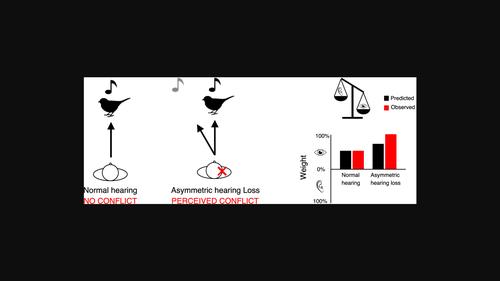当前位置:
X-MOL 学术
›
Eur. J. Neurosci.
›
论文详情
Our official English website, www.x-mol.net, welcomes your feedback! (Note: you will need to create a separate account there.)
The impact of acute asymmetric hearing loss on multisensory integration
European Journal of Neuroscience ( IF 3.698 ) Pub Date : 2024-02-01 , DOI: 10.1111/ejn.16263 Sanne Böing 1 , Stefan Van der Stigchel 1 , Nathan Van der Stoep 1
European Journal of Neuroscience ( IF 3.698 ) Pub Date : 2024-02-01 , DOI: 10.1111/ejn.16263 Sanne Böing 1 , Stefan Van der Stigchel 1 , Nathan Van der Stoep 1
Affiliation

|
Humans have the remarkable ability to integrate information from different senses, which greatly facilitates the detection, localization and identification of events in the environment. About 466 million people worldwide suffer from hearing loss. Yet, the impact of hearing loss on how the senses work together is rarely investigated. Here, we investigate how a common sensory impairment, asymmetric conductive hearing loss (AHL), alters the way our senses interact by examining human orienting behaviour with normal hearing (NH) and acute AHL. This type of hearing loss disrupts auditory localization. We hypothesized that this creates a conflict between auditory and visual spatial estimates and alters how auditory and visual inputs are integrated to facilitate multisensory spatial perception. We analysed the spatial and temporal properties of saccades to auditory, visual and audiovisual stimuli before and after plugging the right ear of participants. Both spatial and temporal aspects of multisensory integration were affected by AHL. Compared with NH, AHL caused participants to make slow, inaccurate and unprecise saccades towards auditory targets. Surprisingly, increased weight on visual input resulted in accurate audiovisual localization with AHL. This came at a cost: saccade latencies for audiovisual targets increased significantly. The larger the auditory localization errors, the less participants were able to benefit from audiovisual integration in terms of saccade latency. Our results indicate that observers immediately change sensory weights to effectively deal with acute AHL and preserve audiovisual accuracy in a way that cannot be fully explained by statistical models of optimal cue integration.
中文翻译:

急性不对称性听力损失对多感觉统合的影响
人类具有整合不同感官信息的卓越能力,这极大地促进了环境中事件的检测、定位和识别。全球约有 4.66 亿人患有听力损失。然而,很少有人研究听力损失对感官协同工作的影响。在这里,我们通过检查正常听力 (NH) 和急性 AHL 的人类定向行为,研究常见的感觉障碍,即不对称传导性听力损失 (AHL) 如何改变我们的感官相互作用的方式。这种类型的听力损失会扰乱听觉定位。我们假设这会造成听觉和视觉空间估计之间的冲突,并改变听觉和视觉输入的整合方式以促进多感官空间感知。我们分析了塞住参与者右耳之前和之后眼跳对听觉、视觉和视听刺激的空间和时间特性。多感觉整合的空间和时间方面都受到 AHL 的影响。与 NH 相比,AHL 导致参与者对听觉目标进行缓慢、不准确和不精确的扫视。令人惊讶的是,视觉输入权重的增加导致了 AHL 的准确视听定位。这是有代价的:视听目标的眼跳延迟显着增加。听觉定位误差越大,参与者能够从眼跳延迟方面的视听整合中受益的程度就越少。我们的结果表明,观察者会立即改变感官权重,以有效地应对急性 AHL 并保持视听准确性,而这种方式无法通过最佳线索整合的统计模型来完全解释。
更新日期:2024-02-02
中文翻译:

急性不对称性听力损失对多感觉统合的影响
人类具有整合不同感官信息的卓越能力,这极大地促进了环境中事件的检测、定位和识别。全球约有 4.66 亿人患有听力损失。然而,很少有人研究听力损失对感官协同工作的影响。在这里,我们通过检查正常听力 (NH) 和急性 AHL 的人类定向行为,研究常见的感觉障碍,即不对称传导性听力损失 (AHL) 如何改变我们的感官相互作用的方式。这种类型的听力损失会扰乱听觉定位。我们假设这会造成听觉和视觉空间估计之间的冲突,并改变听觉和视觉输入的整合方式以促进多感官空间感知。我们分析了塞住参与者右耳之前和之后眼跳对听觉、视觉和视听刺激的空间和时间特性。多感觉整合的空间和时间方面都受到 AHL 的影响。与 NH 相比,AHL 导致参与者对听觉目标进行缓慢、不准确和不精确的扫视。令人惊讶的是,视觉输入权重的增加导致了 AHL 的准确视听定位。这是有代价的:视听目标的眼跳延迟显着增加。听觉定位误差越大,参与者能够从眼跳延迟方面的视听整合中受益的程度就越少。我们的结果表明,观察者会立即改变感官权重,以有效地应对急性 AHL 并保持视听准确性,而这种方式无法通过最佳线索整合的统计模型来完全解释。



























 京公网安备 11010802027423号
京公网安备 11010802027423号